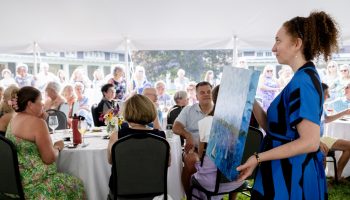Launched a mere eight months ago, on Christmas 2021, the James Webb Space Telescope is the largest optical telescope in space. Its primary mirror consists of 18 hexagonal mirror segments that together extend six and a half meters in diameter.
Using infrared radiation, the JWST has been revolutionizing what astronomers have theorized about objects that are too distant, early or faint for the Hubble Space Telescope, which was propelled into low-Earth orbit in 1990.
It is conceivable that billions of planets outside of Earth’s solar system yet within our Milky Way galaxy — referred to as extrasolar planets and more commonly as “exoplanets” — may be habitable.
At 9:15 a.m. on Thursday, Aug. 25 at the Chautauqua Women’s Club, Thaddeus “Tad” Komacek will discuss “Finding Earth 2.0: How We Can Determine Which Exoplanet May Be the Next Earth.”

His presentation, which he said will include actual images of detectable exoplanets, will be the final talk in the CWC’s 2022 Chautauqua Speaks lecture series.
This is not the first time that Chautauquans will be learning about exoplanets.
On July 19, 2016, during the Chautauqua Lecture Series’ week on “Our Search for Another Earth,” Sara Seager, Massachusetts Institute of Technology professor of planetary science and physics, said on the Amphitheater stage:
“Like rolling the dice, each planetary system forms differently. When we think about finding an earth, a planet just like ours, it’s incredibly challenging.”
Komacek welcomes this challenge.
“The reason that the field of exoplanets is exciting to me, is that (it’s) younger than me,” he said. “It started in 1992 with the first detection of a weird star, a neutron star, made of different matter than the sun. … My life is following it. It’s growing as a science as I’m growing as a scientist.”
He pointed to the first discovery, in 1995, of a planet outside of our solar system, but still in the Milky Way, that is somewhat like the sun and orbits a solar-type star.
That year, Swiss astrophysicist Michel Mayor and astronomer Didier Queloz used custom-made instruments at the Haute-Provence Observatory in southern France to detect a gaseous ball comparable in size to Jupiter; it was named 51 Pegasi b.
And in 2019, they shared the Nobel Prize in Physics with Canadian-American astrophysicist Jim Peebles.
Since the completion of its commissioning stage on July 11, scientists have been receiving spectacular images and surprising data from the JWST as it orbits the sun approximately 1.5 million kilometers from Earth.
“In one-and-a-half months, it’s been transforming what we know,” Komacek said. “… The field is still very new, so methodologies to understand and characterize exoplanets have changed rapidly. Sometimes a new observation will flip on its head what we thought.”
For Komacek and his colleagues, “that’s both exciting and a challenge. It’s new, so we’re still trying to understand fundamental things that will shift very drastically over time.”
Growing up outside Philadelphia, Komacek said that he became interested in space at a young age. For decades, Penny Leon Glackman, his fifth-grade teacher at Merion Elementary School, infused her curriculum with aeronautical and space science. Glackman’s initiative gained her a place in a two-week NASA educator program at the Kennedy Space Center in Cape Canaveral, Florida.
“She went above and beyond,” Komacek said. “She integrated NASA and space exploration into math and history.”
Glackman was repeatedly lauded for her work. In May 2011, she was selected as one of 85 teachers nationwide to receive the Presidential Award for Excellence in Mathematics and Science Teaching. And in 2013, she was included on the National Air and Space Museum’s Wall of Honor in Washington.
As it happens, when Komacek was finishing high school in 2009, NASA launched the Kepler Space Telescope to detect Earth-sized planets orbiting other stars. He said that that’s when the study of exoplanets took off.
“It was the first telescope built just to study and characterize exoplanets. It found thousands of (them) during my undergraduate years. It placed our own solar system in context.”
At the University of Chicago, which Komacek said had hired “amazing exoplanet professors,” he double-majored in physics with a specialization in astrophysics and in geophysical sciences, and he wrote his honors thesis on planet formation. In addition, he designed and taught introductory astronomy courses to local high school students.
From 2013 to 2018, Komacek earned his Master of Science and doctorate in planetary sciences at the University of Arizona, where he studied at the Lunar and Planetary Laboratory.
“At the University of Arizona, the field changed from finding exoplanets to understanding what they’re like — their nature, atmosphere, temperature patterns — so we can start making crude maps,” Komacek said. “We’re trying to make sense of observations from NASA and the Spitzer telescope of the three-dimensional nature of these exoplanets.”
NASA launched the Spitzer Space Telescope for infrared astronomy in 2003, and ended its operations in January 2020, a year before sending the JWST into orbit.
The exoplanets detected are “unlike any planet in our solar system,” Komacek said. “They’re very close-in to their host star. … The average is 20 times closer-in to the host star than the Earth is to the sun.”
Because they are very hot and are about the size of Jupiter, he said they’re called “hot Jupiters.”
Returning to the University of Chicago as the 2018-2021 Heising-Simons Foundation’s 51 Pegasi b Postdoctoral Fellow, Komacek co-authored several peer-reviewed articles.
Since August 2021, he has served as assistant professor of astronomy at the University of Maryland, College Park. He teaches undergraduate and graduate students, one course per semester — “Life in the Universe” and “Introduction to Astronomy” so far.
The remainder of Komacek’s academic work is spent doing research, applying for grants and mentoring students. He said his current research interests are, “hot and ultra-hot Jupiter atmospheric dynamics; atmospheric dynamics and climate of temperate rocky exoplanets; planetary internal evolution.”
On Thursday, he will be discussing “the opportunity moving forward with the JWST and also future space telescopes. The dream of our field is to understand if the Earth is unique. The JWST will study planets the size of the Earth and … stars the size of the Earth. They’re the same size, but they may not be the same because of their stars.”
Komacek will also describe the scientific challenges of directly detecting another Earth that could host a biosphere indicative of life, and of mapping the surface of this Earth twin.




